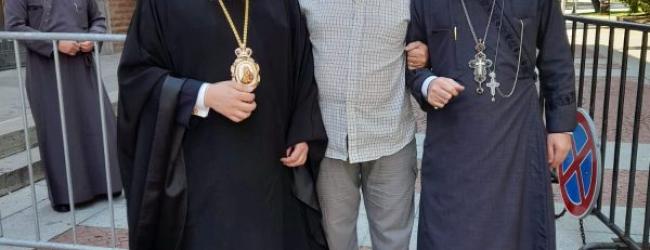The church of Bitonto flies to Sofia, located in the Balkan peninsula of Thrace at the crossroads between East and West. Sofia is the third oldest capital of Europe after Rome and Athens. It was represented by prof. Giuseppe Cannito theologian who brought the cordial greetings of Msgr. Giuseppe Satriano archbishop of Bari-Bitonto, of Msgr. Angelo Latrofa director of the diocesan school office, of don Giovanni Giusto territorial episcopal vicar, of don Michele Lacetera episcopal chancellor, of don Francesco Acquafredda co-cathedral parish priest, of don Vito Piccinonna parish priest-rector of Basilica Santi Medici, of father Santo Pagnotta general secretary of the Faculty of Theology Ecumenical-Patristic “San Nicola” of Bari. This ecumenical and cultural journey is part of the university academic course held at the Apulian Theological Faculty of Bari, with the contribution of the National Service for Higher Studies of Theology and Religious Sciences of the Italian Episcopal Conference , centered on the phrase of Pope Francis “Recognizing the value of the grace granted to other Christian communities”. In the city of Sofia last Tuesday 5 July solemnity of the nativity of St. John the precursor in the early Christian Orthodox Basilica of Sveta Sophia, the oldest church in the Bulgarian capital dating back to the IV-V century dedicated to the divine wisdom of God, Metropolitan His Beatitude Polycarp in receiving as a gift the sacred votive images of the Immaculate Conception and the Saints Doctors of Bitonto reiterated – “The cult of the Madonna, of St. Nicholas and of the Saints Cosma and Damiano are deeply rooted in Bulgaria and unite the Orthodox and the Catholic Church”. On Wednesday 6 July we visited the Catholic Cathedral of St. Joseph (the only Latin rite church in the Bulgarian capital) is located in the unique ecumenical religious quadrilateral with the Orthodox Cathedral Sancta Nedelja (neo-Byzantine architecture), the Banja Bashi mosque (Ottoman architecture) and the Jewish synagogue (neo-Moorish architecture). Following the visit to the immense Orthodox Cathedral of Alexander Neyskij of the nineteenth century in the neo-Byzantine style, it is certainly the main attraction of the capital as well as being the undisputed symbol of Bulgaria, the domes are covered with a gold foil, all inside you can admire the majestic and refined mosaics and the precious icons, unique in the world declared a Unesco World Heritage Site. Then the visit to the Russian Orthodox Tsurkva Sveta Nikolai church of the nineteenth century, a small jewel, easily recognizable thanks to five domes covered with green and golden tiles, the internal walls adorned with paintings, in the crypt you can observe the faithful intent on writing notes addressed to the Metropolitan Seraphim and put them on his tomb to receive protection, then the visit to the Rotonda Sveti Georgi it is a Roman archaeological site with a tiny Greek-Byzantine Orthodox church built in the fourth century in a circular shape with valuable frescoes, in it we participated in the Orthodox liturgy according to the canon of the rite of anointing with the sacred perfumed oil receiving it on the forehead with a blessing. The cultural visit ended with a surreal walk in seeing the majestic bronze and gold laminated statue of Santa Sofia, it is the symbolic monument of the Bulgarian capital, adjacent to it is the monumental Presidential Palace where at 12:00 it was possible to attend at the changing of the guard parade. This ecumenical and cultural visit is a sign of the spiritual brotherhood between the two churches reaching out towards an ecumenical path, inviting the Orthodox to visit the city of Bitonto rich in history, art and spirituality, among which the splendid 12th century Apulian Romanesque cathedral stands out. -XIII century.

